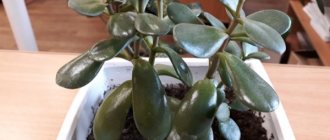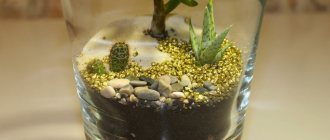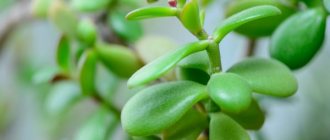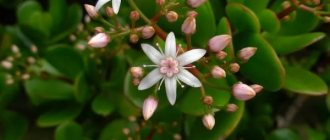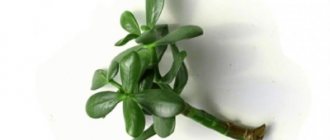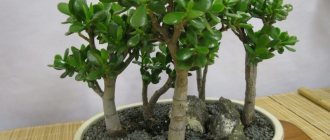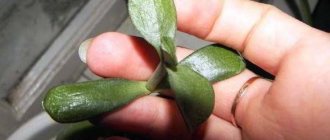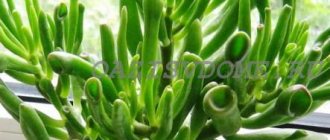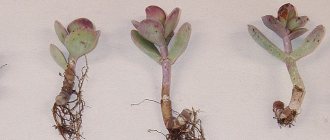There is hardly a person among us who has never seen or heard of a houseplant called the money tree. This is Crassula or Crassula, a very decorative and completely unpretentious flower. It is called the money tree because it is believed to bring wealth to the owner’s home. Thanks to this belief, and also because of the amazing shape of the evergreen glossy leaves, similar to shiny coins, the Crassula has settled in the homes of almost all flower growers. If you don't already have this plant, we will introduce you to its many species and hybrid varieties. Perhaps you will find a copy that suits you. And after that, we advise you to read the article Money Tree - care at home.
Description of Crassula (Crassula)
The genus Crassula is quite numerous and is distinguished by a variety of species. Most of them belong to the succulents of the Crassulaceae family, of which there are more than 350 species in nature. They grow in the driest places on our planet. The more complex the living conditions, the more bizarre their appearance, the more interesting their coloring and the more unusual the flowers. Crassula grows in Madagascar and in the south of the Arabian Peninsula. Most of the Crassulas are in South Africa. Translated from Latin, “Crassula” means “thick”. The leaves of Crassula live up to the name of the flower - they are fleshy and thick. In terms of external characteristics, different types and varieties of Crassula are very different from each other. Among them there are very tiny plants, but there are also giant trees, up to several meters in height. But all species have similarities - this is the opposite arrangement of leaves on the stem and the absence of dissection of the leaf blades. Moreover, each pair of leaves is located at right angles to the previous pair. Crassula flowers of different colors are usually small in size and collected in inflorescences. The number of stamens and the number of petals are the same.
All Crassula species contain arsenic in the juice of the leaves. Eating leaves is dangerous to life!
Many species of Crassula live well in our apartments, but some are cultivated only in greenhouses. The most common Crassula species in indoor floriculture can be divided into three groups: tree-like, creeping (groundcover) and spicate (columnar). Let's consider each type in order.
Crassula flower: pests and diseases
The biggest problem for Crassulas will be stagnation of water in the soil. This can cause root rot. Succulents can also suffer from drafts; in this case, the trees may dry out and the leaves may fall off.
Among the pests, the most popular are mealybugs. To eliminate them, you will need a cotton wool that is well moistened in an alcohol solution. Scale insects are also sometimes found. To combat them, treatment with Actellik is suitable. Fitoverm helps best against spider mites.
Tree Crassula
Because of its leaves that look like coins, the tree-like Crassula is called differently in different countries: “Silver Tree”, “Silver Dollar”, “Coin Tree”, “Tree of Happiness”. The following names have stuck with us: “Money Tree” or Crassula.
This group includes the most popular types of Crassula due to their unpretentiousness and spectacular appearance. Grown as bonsai, mini-trees with a beautiful crown and thick fleshy stem can decorate the interior of any room.
Here are the most common tree-like varieties of Crassula (Crassula, Money tree) in indoor floriculture:
Oval or Ovata (Ovata)
Crassula Ovata
Ovata is the most unpretentious, shade-tolerant and, therefore, the most common variety of Crassula in amateur floriculture. She is originally from South Africa. The height of the tree varies from 60 cm to one meter. Its woody stem is highly branched. Over time, it turns brown. Evergreen glossy, often with reddish edges, leaves grow without petioles, in the shape of an ellipse. They are up to 5 cm long and up to 2.5 cm wide. The underside of the leaves has a reddish tint. Thick, numerous leaves are capable of retaining large amounts of moisture. An adult plant blooms in autumn-winter. Small star-shaped flowers are white and pink in color. Ovata can withstand temperature drops of up to 10 degrees, even short-term mild frosts do not bother it.
This may be interesting: Prickly pear - growing at home
Purslane (Portulacea)
Crassula Portulacea
Crassula Portulaca is a variety of Ovata and is similar to it in many ways. Also a very common species in home gardening. It is distinguished by the presence of aerial roots on the trunk and branches, initially white, and darkening over time. It blooms only in adulthood and not always. Its small flowers are collected in paniculate inflorescences. The color of the petals is white and pink.
Silver (Argentea)
Silver Crassula (Crassula Argentea)
Another variety of Ovata. It differs in that the green surface of the leaf blades is covered with light specks. And the leaves have a silver shine.
Ovata Minor
Crassula Ovata Minor
This is a compact form. Its variety “Crosby's Compact” is much smaller in size than the natural variety. The young plant has a fleshy green trunk that becomes woody over time. The oblong small dark green leaves have a red edge along the edges. Their size does not exceed 1.5 cm in length and 1 cm in width. The flower grows slowly and looks great in mini-gardens.
Ovata var. Oblique
Crassula Ovata var. Oblique
This is a less common form of Ovate. It is distinguished by pointed leaves with a slightly raised tip and slightly curved down sides. The leaves are slightly larger than those of Ovata.
Ovata var. Oblique cv. Tricolor and Ovata var. Oblique cv. Solana.
Crassula ovata var. Oblique cv. Solana
These hybrids are a variety of Crassula obliqua. The tricolor has white stripes against a background of bright red trim. Solana leaves are decorated with bright yellow stripes that are arranged asymmetrically. Their number varies among different shoots. On some leaves, there are no chlorophyll-free areas at all. We recommend removing completely green shoots so that the flower does not lose its diversity and decorativeness.
Milky (Lactea)
Milky Crassula (Crassula Lactea)
This is a fairly large subshrub (up to 60 cm) with fairly large leaves decorated with white dots along the edges. And the Milk Crassula blooms with thick white panicles. Hence the name of the species.
The Hobbit and Gollum
Crassula the Hobbit
Crassula Gollum
These hybrids were obtained by US breeders in the 70s of the last century from crossing Crassula Ovata and Milky. They are similar to each other. They have an original leaf shape. The Hobbit's leaves are turned outward and fused from the base to the middle, while Gollum's leaves are completely curled into a tube with funnel-shaped flaring tips. The growth pattern and size of the tree are the same as those of the common species Crassula Ovata, only their trunks are even more branched. Hybrids are very decorative and suitable for creating bonsai. They have several variegated forms.
Ovata cv. Hummel's Sunset
Crassula ovata cv. Hummel's Sunset
This hybrid has leaves decorated with white or yellow stripes and a pronounced red border along the edge. The Dutch variety of Ovata, purchased under this name, with very beautiful yellow-red leaves, may disappoint you, since the color of the leaves retains its original color only under constant bright light, which can be organized in greenhouses, but at home, usually, the leaves become just green .
Arborescens
Crassula Arborescens
This large tree, up to 1.5 m in height, has almost round leaves (7 cm long and 5 cm wide). The color of the leaves is bluish-gray, along the edge there is a narrow red border. The underside of the leaves is reddish. The leaf blades are often covered with dark specks. The flower is very decorative, in appearance it resembles Crassula Ovata, but is more demanding in care - it loves good lighting and does not tolerate waterlogging of the roots at all. At home, it rarely blooms with small white flowers. A miracle can happen if you guess the location of the pot (the western side of the apartment is preferable to others), lighting and watering. But even without flowers, the decoration of the flower is its juicy, fleshy, glossy leaves.
Reproduction methods
Crassula propagates in three ways: cuttings, seeds and leaves. Let's consider each method separately.
Most gardeners use growing new specimens from cuttings. It's simple if you follow a clear algorithm:
- Place the cutting in water with the addition of charcoal and wait for the roots to appear.
- Plant the new plant in a pot (diameter 6 cm).
- Compose the soil from equal parts of river sand, turf and leaf soil.
- Place the pot with the new Crassula in a well-lit place with an air temperature of up to 17 C.
- Water once a day.
Few people like to “play” with seeds, so this method of propagation is not very popular. If you have a lot of free time and a strong desire to start with the most difficult ones, try multiplying using the following tips:
- Place the seeds on the surface of the soil mixture (the soil is prepared as for cuttings).
- Sprinkle water from a spray bottle on top.
- Cover lightly with soil.
- Cover with clear plastic wrap.
- Remove the film once a day to allow the soil to breathe and not mold.
- When the first shoots appear, water them once a day.
Propagation by leaves is not used for all varieties of Crassula. Leaves that have roots in places adjacent to the trunk are suitable here. Select a healthy, strong leaf and leave for 48 hours in a warm, dry room. As soon as the leaf wilts, start rooting:
- Pour the growth stimulator solution into a small glass.
- Deepen the leaf 1 cm into it.
- Place the container on a warm, well-lit windowsill.
You can reproduce it differently:
- Place the leaf on the edge of the pot and dig down 2 cm.
- Add crushed red brick to the soil mixture (this will prevent water from stagnating and the leaf rotting). Instead of soil, you can use crushed sphagnum.
- Moisten the soil.
Methods 1 and 3 provide the highest efficiency. Within a month, the cuttings and leaves begin to produce roots.
Ground cover (cresting) Crassula
These are herbaceous plants that grow very quickly and cover the space allocated to them with a carpet.
Lycopodioides
Crassula Lycopodioides
This species is noticeably different from others. A small bush (no higher than 25 cm) is very similar to a fancy coral or moss. It reproduces well, quickly produces many shoots, which literally fall out of the pot in a matter of weeks. The shoots are creeping, tetrahedral, fleshy, their tips are slightly raised upward. In appearance, the flower is similar to a moss - hence the name. Thin and pointed leaves in the form of small scales are folded in four rows and fit tightly to the trunk and to each other. From a distance, the stems resemble green ribbed worms. In intense light they take on a reddish tint. This Crassula blooms with small white star-shaped flowers, inconspicuous in appearance. Grows well in the shade. Unpretentious. Often used as a ground cover plant in gardens, in the form of a green lawn. It also serves as an excellent beautiful background for other flowers and gets along with any type of plant.
This may be interesting: Decembrist (Schlumberger) - description, types and varieties
Pseudolycopodioides (C. Lycopodioides ssp. Pseudolycopodioides)
Crassula Lycopodioides ssp. Pseudolycopodioides
It is a variety of Moss-moss. It is distinguished by more curved stems and leaves less pressed to the stem. The stem blades are more spread out and, depending on the Crassula variety, may have a variegated, silver or yellow color.
Tetralix
Crassula Tetralix
The tetrahedral Crassula has fleshy, subulate-shaped leaves with a pointed tip. The leaves are up to 4 cm long and 0.4 cm thick. They are located throughout the stem at a short distance from each other. Its stems are abundantly overgrown with brown aerial roots, designed to capture moisture from the air. This shrub is easy to form into a small, showy tree.
Spot (Picturata)
Crassula dotted (S. picturata)
Very decorative look. It has lodging, strongly branching shoots. The leaf size is up to 1.5 cm in length and 0.8 cm in width. The green surface of the leaves is covered with red dots, and the reverse side is covered with purple-red dots. Thin transparent eyelashes are placed along the edges. Crassula punctata is used as an hanging plant.
Offspring (Sarmentosa)
Crassula Sarmentosa
This small perennial, abundantly branching herbaceous plant has pointed leaves, which are decorated with teeth along the edges. In addition, the edge of the leaf is often variegated: red or light green. Stems up to one meter long quickly spread across the area allocated for the plant and easily take root, giving life to new shoots. The shoots reach a meter in length, and the leaves - 3.5 cm. Flowers from 5 to 8 mm in diameter are collected in white or cream-colored panicles.
Crassula Round or Rosette (C. Orbicularis/Rosularis)
Crassula Orbicularis/Rosularis
This is a perennial herbaceous plant. In appearance it resembles an aeonium - its leaves are collected in rosettes similar to flowers. They are fleshy, light green in color, with pointed reddish tips. The length of the leaf barely reaches 2.5 cm. The plant branches abundantly and quickly occupies the area allocated for it.
Home care
| lighting | Needs good daylight, but without direct sunlight on the leaves. |
| temperature | In summer - from 20 to 25 degrees Celsius. In winter - no higher than 13-15 degrees (better - lower, but the lower limit is 5 degrees Celsius). Doesn't like temperature changes, prefers stability. |
| location | East or west windows are good for Crassula. When placed on south-facing windows, shading may be required. |
| watering | Watering with settled water at room temperature as the earthen clod dries out. In summer - a couple of times a week. During wintering - once a month. Monitor the condition of the plant: if the leaves are wrinkled, extraordinary watering is necessary. Overwatering of Crassula is very dangerous; Crassula is originally a resident of arid regions. |
| air humidity | It does not require any measures in this regard: the plant is unpretentious and by nature undemanding to moisture. It is worth spraying and wiping the leaves from dust a couple of times a month (during the warm season). |
| feeding | Fertilize during the active growing season with fertilizer for succulents twice a month. It is good to combine it with watering. |
| the soil | Ready soil for succulents. Or mix the soil yourself at the rate of 1 part turf soil, 3 parts leaf soil and 1 part oven-calcined river sand. Be sure to add drainage (pieces of broken brick). |
| pruning | Can be pruned to properly form the crown. |
Spike-shaped (columnar, columnar) Crassula
This group of Crassulas got its name because of its unusually picturesque structure. These are upright bushes with little or no branching stems. Their paired leaves grow together at their bases and envelop the stem in such a way that it seems that they are tightly strung on the stem.
Perforata
Crassula Perforata
This small plant has diamond-shaped leaves that are arranged in pairs, fused at the base and encircling the stem. The arrangement of leaves is cross-shaped. The stem is sparsely branched and rigid. The leaves are light green in color with a bluish bloom and a red border along the edge. Leaf length is up to 2 cm. Trunk length is up to 20 cm, and the diameter of the trunk with leaves is about 3 cm. Flowering occurs in winter. Numerous small white flowers are collected in dense inflorescences at the top of the shoot. Perforata can be grown as a hanging plant.
Perforata Variegaga (C. perforata Variegaga)
Crassula Perforata Variegaga
This is a variety of Perforata. Young leaves have bright yellow stripes along the edges or in the middle, while older leaves, at the bottom of the trunk, are completely green. In spring the plant turns completely green.
Grouped (Socialis)
Clustered Crassula (Crassula socialis)
This low-growing perennial herbaceous plant has thin, highly branched stems on which leaf rosettes are densely arranged. The leaves are round, small, smooth, flat, up to 5 mm in length. Their color is bluish-green. Thin cilia are located along the edge of the leaf blade. Crassula Grouped grows well, forming a dense cushion. Inflorescences occur on the tops of shoots. The flowers are white-pink, small.
Rock (Rupestris)
This tall plant has creeping or erect stems up to 50 cm high. Its shoots are initially herbaceous, and in maturity they become tree-like. They spread horizontally, only slightly stretching the tops of the shoots upward. With proper appropriate pruning, this subshrub can produce a beautiful looking bonsai. Its leaves are dense, smooth, depending on the variety - diamond-shaped or ovoid, up to 2.5 cm long and 1-2 cm wide. The leaves are placed on the stems in pairs and crosswise. Due to the fact that there are no petioles, and the bases of the leaves are fused and tightly clasped around the stem, the bush looks very decorative - it seems as if the leaves are strung on stems like beads. The color of the leaf blades is usually light green with a blue tint. Along the edge there is a dotted or continuous stripe of a reddish-rusty color. Crassula Rock blooms in the summer with pink or yellowish fragrant umbrellas.
This may be interesting: Aloe is the green doctor
Cooper
Cooper's Crassula Cooperi
This is a miniature ground cover plant. Its height is no higher than 15 cm. The leaves have a sharp tip with a large fiber in the center, the edge of the leaf has sparse fibers. The color of the leaves is unusual - brown-green with brown spots. The leaves are arranged in a spiral on the stem. The top of each Crassula Cooper stem is crowned with an inflorescence of small, white or pink flowers. Flowering is long lasting.
Buddha's Temple
Crassula cv. Buddha`s Temple
Crassula Buddha Temple is an erect, almost non-branching plant, forming compact square dark green columns of leaves tightly pressed to the stem. The tip of each leaf is curved upward, making the column resemble the roof of a Chinese pagoda. It grows slowly, no more than 3-5 cm per year. The leaves are paired, fused at the base, succulent, triangular. Their length is about 1 cm, width at the base is up to 2.5 cm. As the shoot develops, the leaves are tightly stacked one on top of the other. Quadrangular columns of regular shape are formed. If you look at the bush from above, it looks like a square or cross. Under comfortable conditions, red buds are formed in the dense short apical inflorescences of the plant. The flowers appear pinkish, almost white, sterile.
Monstrosa (Lycopodioides monstrosa)
Crassula Lycopodioides Monstrosa
It has an abnormal growth of stems, like the comb forms of cacti - the shoots grow asymmetrically, with breaks. Their thickness does not exceed 0.5 cm. They are covered with small (2x2 mm) scaly triangular leaves of a yellowish-green color.
Deceptor
Crassula Deceptor
This is a low (up to 10 cm) bush with very short, thick and tetrahedral leaves (1.5 cm). The stem is completely hidden under densely planted leaves of a greenish-gray color with silver inclusions.
Decorative flowering Crassula
Finally, we will introduce you to some decorative flowering varieties of Crassula, which annually delight their owners with colorful blooms.
Crescent (Falcata)
Crassula falcata
Crassula crescent is a subshrub with a straight, slightly branched stem. It reaches a height of one meter. It has sickle-shaped grey-green leaves. They are juicy, fleshy, fused at the base and clasping the stem. Their length is about 10 cm. It blooms in July - August with bright red-orange flowers, which are collected at the top of the shoot into large, up to 20 cm in diameter, umbrella inflorescences. The peculiarity of the variety is that after flowering, the top of the shoot is removed to well-developed leaves. They wait for side shoots to appear, of which one, the strongest, is left. The rest are used for propagation by cuttings.
Schmidt (Schmidtii)
Schmidt's Crassula Schmidtii
Crassula Schmidt is a ground cover variety that is most common in Europe. There it is grown as an annual, and after the bush has flowered, it is thrown away and new specimens are planted. The height of the bush is no higher than 10 cm. The plant has dense lanceolate leaves, different in shape from other species: they are narrower and pointed at the ends. The color of the leaves is remarkable. They are green on top, with a silvery coating, and slightly reddish on the inside. The stem is also greenish-pink. This Crassula blooms with red, carmine-colored flowers. The plant is distinguished by its remarkable decorative properties and is widely used by landscape designers.
Justi-Corderoyi
Crassula Justi-Corderoyi (C. Justi-Corderoyi)
This variety is also preferred to be planted in Europe as an annual. It is similar to Schmidt's Crassula. Only its leaves are flattened, rounded at the bottom, and the edges have cilia. The flowering plant produces bright carmine buds with reddish inflorescences.
Crassula perfoliata (C. perfoliata)
Crassula perfoliata
This type of Crassula also annually pleases caring gardeners with beautiful flowering. This species can reach a height of 50 to 100 cm. The stems are erect, slightly branched. The leaves, as if strung on a stem, give it a special decorative effect. They are juicy and meaty. They have a triangular or lanceolate shape. Their length is from 10 to 15 cm. The upper surface of the leaves is dotted with red dots, and their edges are covered with a number of barely noticeable, small teeth. Abundant flowering occurs in the summer months. Small flowers are collected in racemose inflorescences. Their color is white or red. A peduncle (about 10 cm) grows from the top of the stem.


